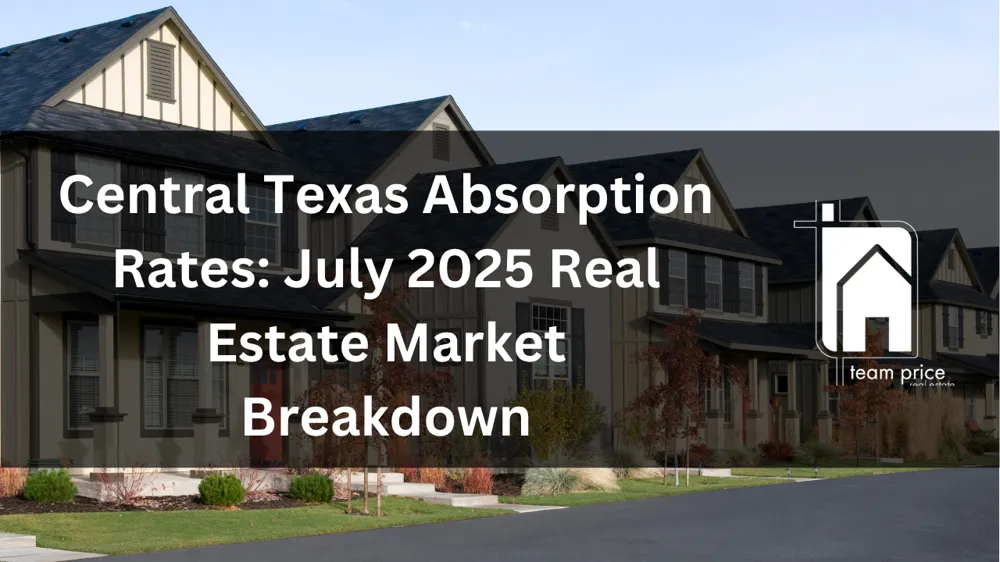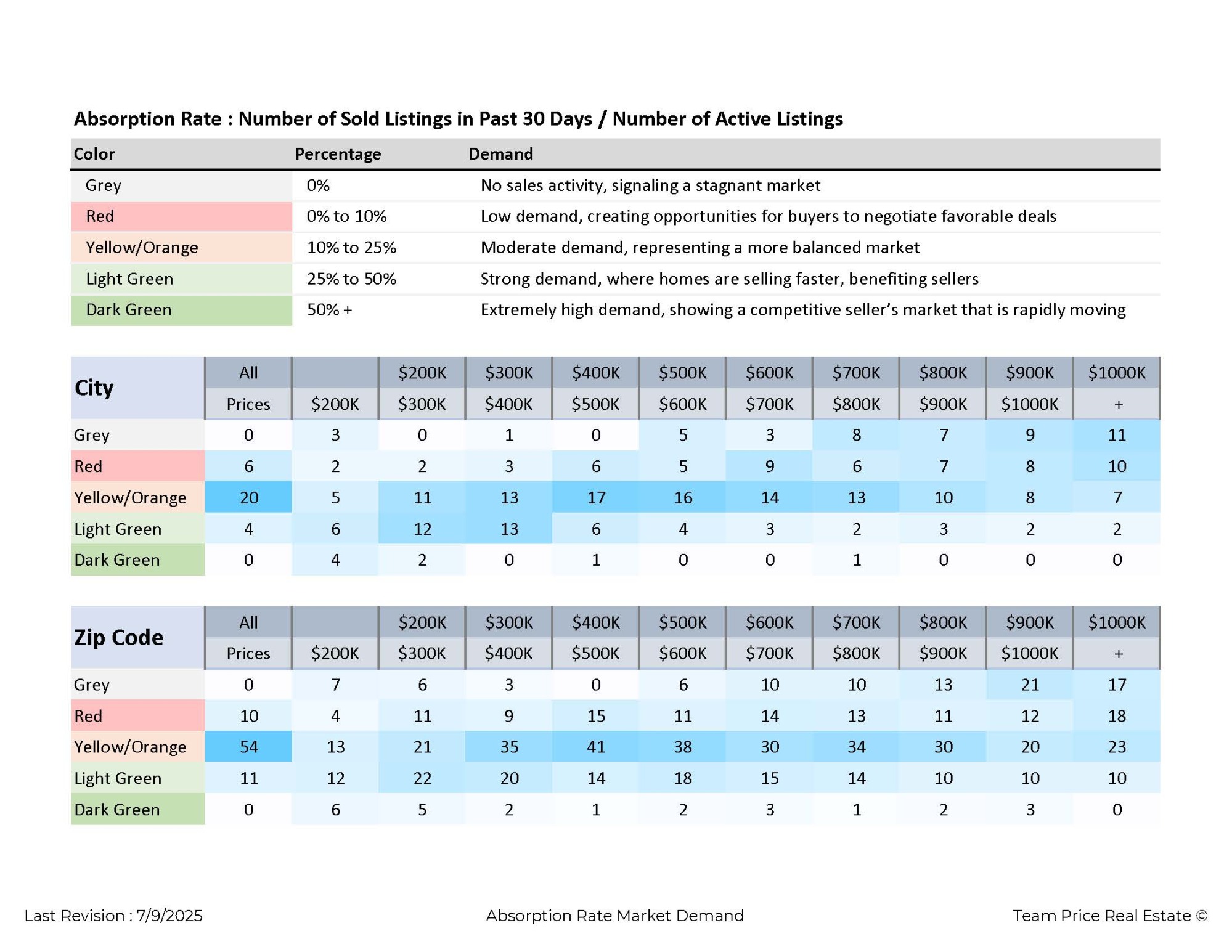July 9, 2025: The Central Texas real estate market continues to show a wide range of activity depending on location and price point. A key measurement in evaluating market conditions is the absorption rate, which is calculated by dividing the number of homes sold in the past 30 days by the number of active listings. This percentage helps buyers and sellers understand whether the market favors sellers, buyers, or remains balanced.
An absorption rate above 25% usually indicates a seller’s market where homes are selling quickly. A rate between 10% and 25% reflects a balanced market, and anything below 10% points to a buyer’s market where homes take longer to sell. If the rate is 0%, it means no sales have occurred in that category during the measured period.
As of July 2025, cities like Buda, Cedar Park, Dripping Springs, and Hutto are experiencing high demand across many price ranges. Buda reports strong absorption in the $200K to $500K range, with rates from 28% to 35%, and even sees a 33% rate in the $1 million+ category. Hutto is notable for its 59% absorption in the $400K range and a perfect 100% rate in the $900K segment. These figures reflect strong buyer activity in those cities.
Cedar Park also shows strong performance, particularly in the $300K to $600K range. Absorption rates here range from 25% to 44%, making it one of the more active markets. Dripping Springs follows a similar pattern, with rates up to 47% in the $300K range and strong demand in several other categories.
In contrast, some cities are seeing much slower activity. For example, Burnet reports several 0% rates, including in the $800K and $1 million+ brackets. Cedar Creek, Jarrell, and Dale also show multiple price points with zero sales, indicating a sluggish market.
Austin remains relatively balanced with absorption rates ranging from 13% to 22% across all price bands. Round Rock shows steady demand as well, especially in the $300K to $900K range, where rates hover between 18% and 28%.
Luxury homes priced above $900K present a mixed picture. While Buda and Cedar Park maintain activity at this level, many other cities such as Jarrell, Dale, and Taylor report 0% absorption, suggesting limited movement in higher-end properties.
City-level differences are pronounced. For example, Kyle shows an unusual 233% absorption rate in the $300K range, which may reflect a low number of active listings combined with strong sales. Leander also has a standout 300% rate in the $200K range. While these high numbers suggest heavy demand, they can also indicate small sample sizes skewing the data.
Overall, the July 2025 absorption rates offer a clear snapshot of buyer behavior in Central Texas. Strong mid-range demand persists in growing areas, while high-end properties remain slower to move in many markets. This information is essential for pricing strategies and setting expectations, whether you are buying or selling a home in the region.
FREQUENTLY ASKED QUESTIONS:
1. What exactly is an absorption rate in real estate?
The absorption rate measures how quickly homes are selling in a market. It is calculated by dividing the number of homes sold in the past 30 days by the number of active listings, then expressing the result as a percentage. For example, a 25% absorption rate means that a quarter of all active listings sold in the last month. A rate above 25% signals a seller’s market with strong demand, 10–25% shows a balanced market, and below 10% indicates a buyer’s market with limited activity. A 0% rate means no sales occurred in that category during the past month.
2. Which Central Texas cities have the highest absorption rates?
Cities like Buda, Hutto, Cedar Park, and Dripping Springs display the most robust absorption rates. In Buda, the $200K–$500K price range sees rates between 28% and 35%, and luxury homes above $1M reach 33%. Hutto stands out with a 59% absorption rate at $400K and a remarkable 100% rate in the $900K segment. Cedar Park reports strong absorption, especially at 44% in the $400K range. Dripping Springs also shows elevated rates of around 47% in the $300K bracket.
3. Which Central Texas markets show weak absorption rates?
Some smaller or rural Central Texas cities are experiencing weak absorption. Burnet, Cedar Creek, Jarrell, and Dale report multiple price tiers with 0% absorption, meaning no homes sold in the last 30 days. For instance, Burnet has 0% sales in the $800K and $1M+ categories. These conditions suggest a buyer’s market with limited buyer interest.
4. How does absorption rate vary by price range in Central Texas?
Affordable and mid-priced homes ($300K–$600K) consistently show high absorption rates, particularly in cities with rising demand. For example, Cedar Park hits 44% in the $400K range. In contrast, luxury price ranges above $900K are more uneven. Round Rock and Austin remain moderate, around 14%–19%, while markets like Jarrell, Cedar Creek, and Dale have 0%, reflecting slower sales among higher-end homes.
5. Why are cities like Kyle and Leander showing unusually high absorption rates?
Certain small sample sizes can exaggerate absorption percentages. For instance, Kyle reports a 233% absorption rate in the $300K bracket, and Leander records 300% in the $200K range. These extreme values typically occur when sales dramatically outpace a limited number of active listings, skewing the percentage. While they signal strong demand, such rates may not reflect long-term trends given the small pool of listings.





